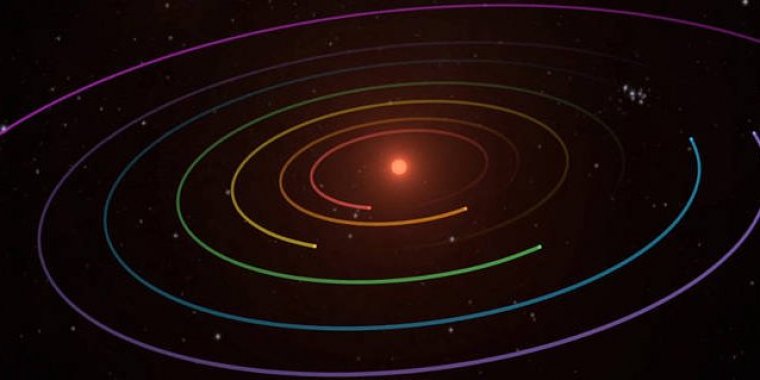| News / Space News |
Astronomers Confirm Orbital Details of TRAPPIST-1’s Least Understood Planet
Scientists using NASA's Kepler Space Telescope identified a regular pattern in the orbits of the planets in the TRAPPIST-1 system that confirmed suspected details about the orbit of its outermost and least understood planet, TRAPPIST-1h.

The orbits of the planets in the TRAPPIST-1 system. ![]()
TRAPPIST-1 is only eight percent the mass of our sun, making it a cooler and less luminous star. It’s home to seven Earth-size planets, three of which orbit in their star's habitable zone—the range of distances from a star where liquid water could pool on the surface of a rocky planet.
The system is located about 40 light-years away in the constellation of Aquarius and is estimated to be between 3 billion and 8 billion years old.
Astronomers from the University of Washington have used data from the Kepler spacecraft to confirm that TRAPPIST-1h orbits its star every 19 days. At six million miles from its cool dwarf star, TRAPPIST-1h is located beyond the outer edge of the habitable zone, and is likely too cold for life as we know it.
The amount of energy (per unit area) planet h receives from its star is comparable to what the dwarf planet Ceres, located in the asteroid belt between Mars and Jupiter, gets from our sun.
Using the prior Spitzer data, the team recognized a mathematical pattern in the frequency at which each of the six innermost planets orbits their star. This complex but predictable pattern, called an orbital resonance, occurs when planets exert a regular, periodic gravitational tug on each other as they orbit their star.
To understand the concept of resonance, consider Jupiter's moons Io, Europa and Ganymede, which is the farthest out of the three.
For every time Ganymede orbits Jupiter, Europa orbits twice and Io makes four trips around the planet. This 1:2:4 resonance is considered stable and if one moon were nudged off course, it would self-correct and lock back into a stable orbit. It is this harmonious influence between the seven TRAPPIST-1 siblings that keeps the system stable.
TRAPPIST-1's seven-planet chain of resonances established a record among known planetary systems, the previous holders being the systems Kepler-80 and Kepler-223, each with four resonant planets.
The TRAPPIST-1 system was first discovered in 2016 by the TRAPPIST collaboration, and was thought to have just three planets at that time. Additional planets were found with Spitzer and ground-based telescopes. NASA's Hubble Space Telescope is following up with atmospheric observations, and the James Webb Space Telescope will be able to probe potential atmospheres in further detail. (NASA)
YOU MAY ALSO LIKE




